If you have really sweaty hands, this post is for you. See, I too have really sweaty hands. And I’ve spent the last five years (not exaggerating) researching and experimenting with different sweaty hand treatments. We’re talking Antihydral, iontophoresis, liquid chalk, Rhino Skin, prescription antiperspirants, over-the-counter antiperspirants… the list goes on.
About four months ago, I finally found something that worked – like, really worked. I almost have normal people skin now. So I’m hoping that all my sweaty-handed friends out there can learn from my trials and errors. I’m going to tell you all about the things I tried, how they worked (or didn’t), and why I liked or didn’t like them. But first, I’m going to impress upon you just how sweaty my skin is.
FYI: this was an experiment with n=1 (as in, it’s all totally anecdotal). This is just what worked for me. If your skin sounds as bad as mine, you could try what I’m using now and see if it works for you. If your skin sounds less sweaty than mine, some of the things that were too mild for me could work well for you. Also, I’m not sponsored by any product company, I didn’t receive anything for free, and none of the things I’ve linked to benefit me in any way.
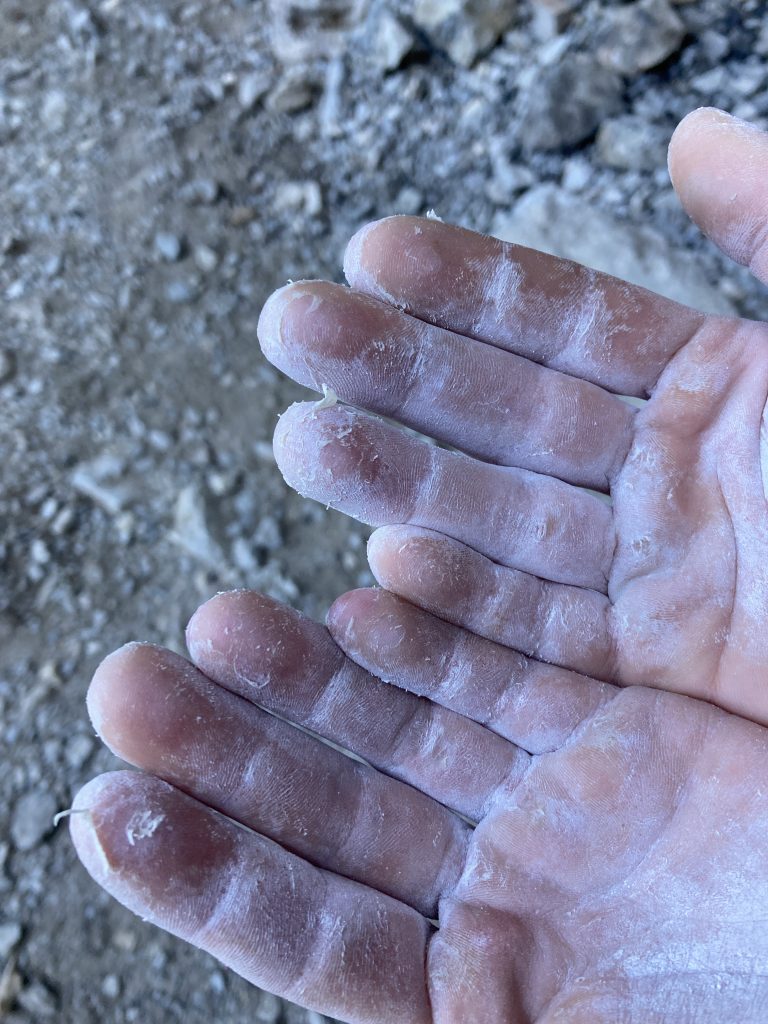
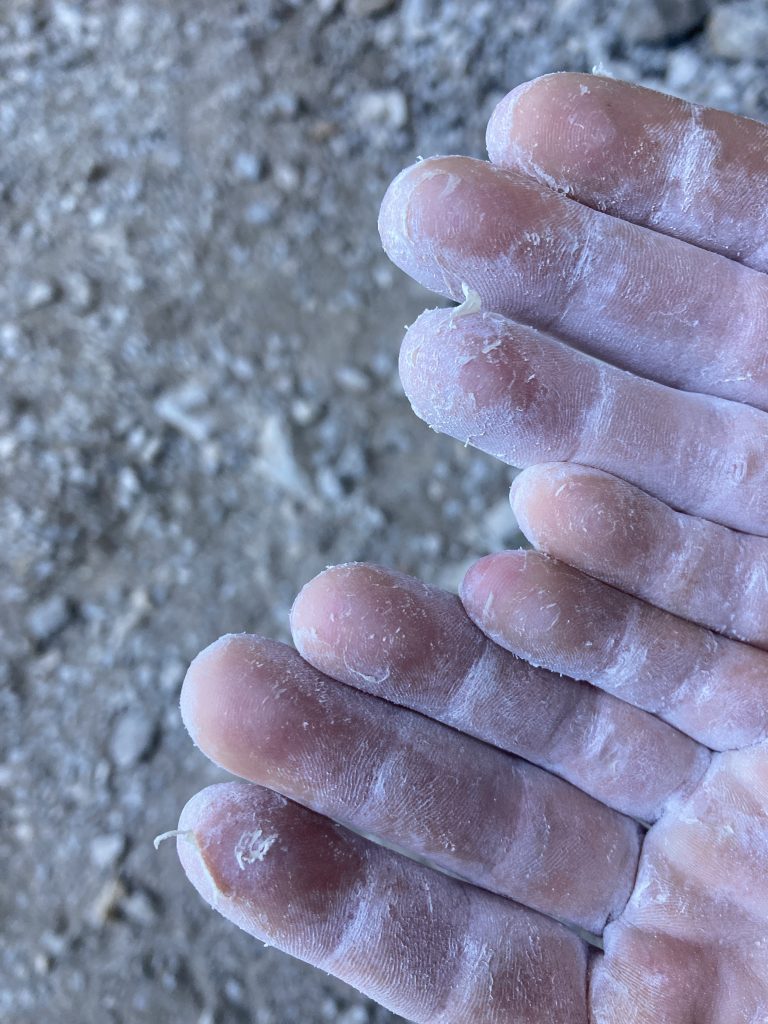
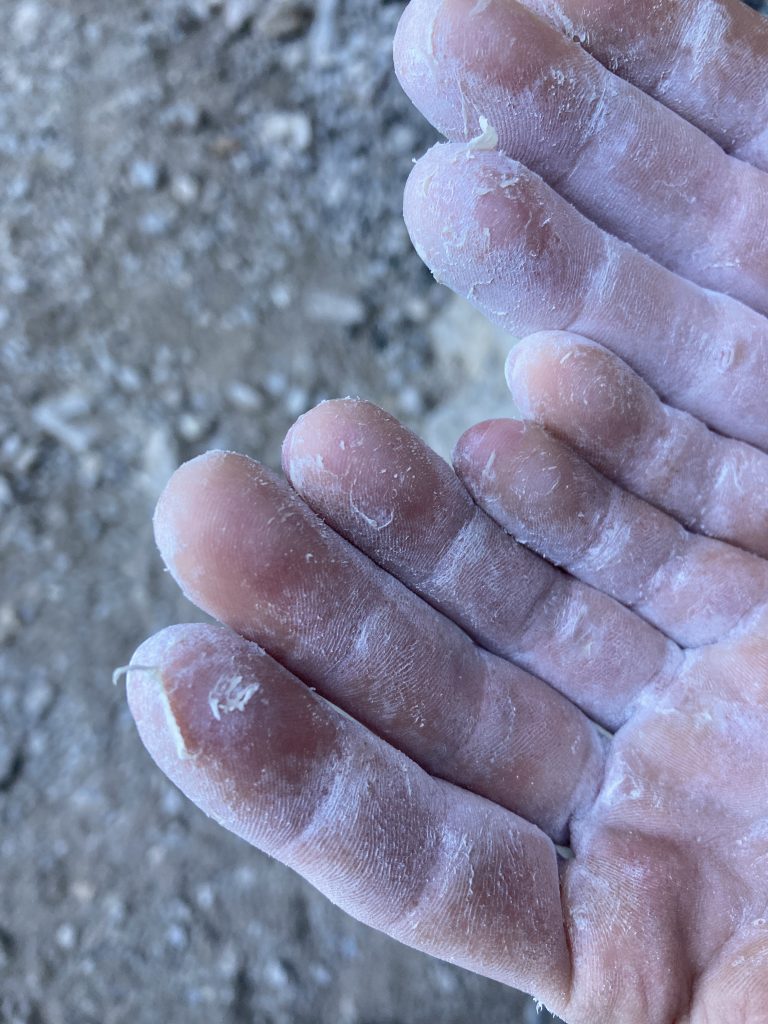
Me, myself, and my skin
I have palmoplantar hyperhidrosis: excessive sweating of the palms of the hands and the soles of the feet. The feet part hasn’t really bothered me. I wear socks with my climbing shoes. When I walk around the gym with socks on, I leave little sweaty footprints everywhere I go. But it doesn’t really affect my climbing.
My palms have been wet all my life. My boyfriends never wanted to hold my hand (lol). In job interviews, I would furiously wipe my hand on my pants before shaking anybody’s hand. My university nickname was “the clam” for my clammy hands. When I did ballet (from about age 5-20), the spot where my hand had been on the wooden barre was always wet – and noticeably so. Apart from being embarrassing, that didn’t really matter. But climbing is obviously a different story.
I’m going to add a series of sweaty hand pics with little descriptions now so you can see what we’re working with.
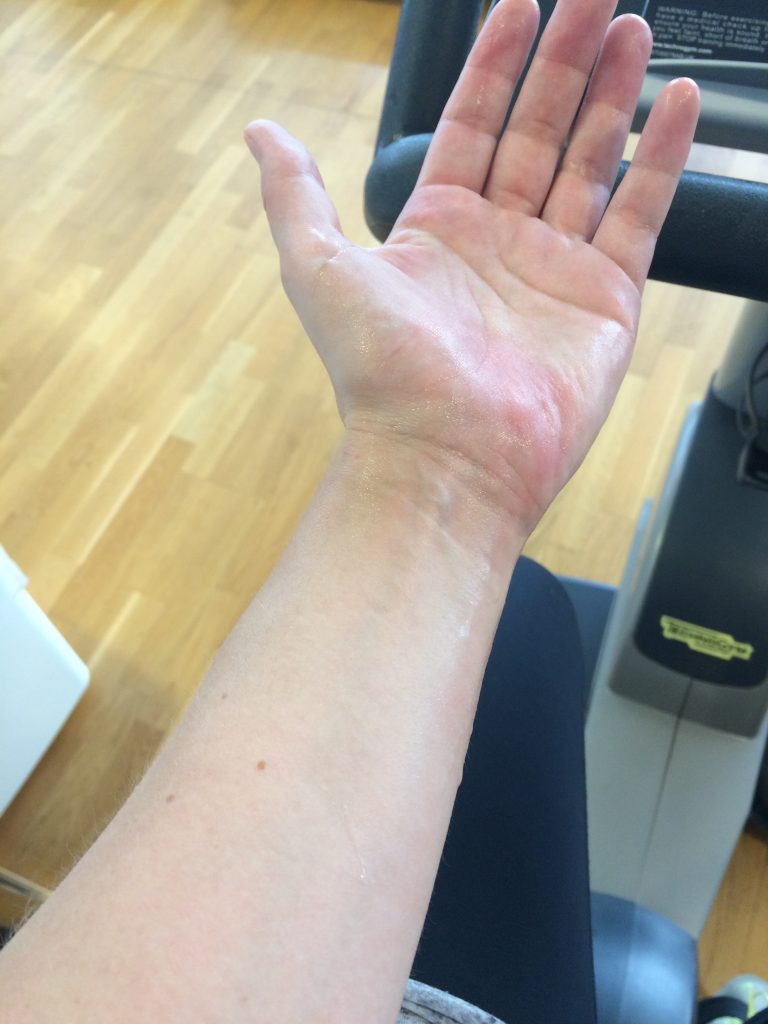
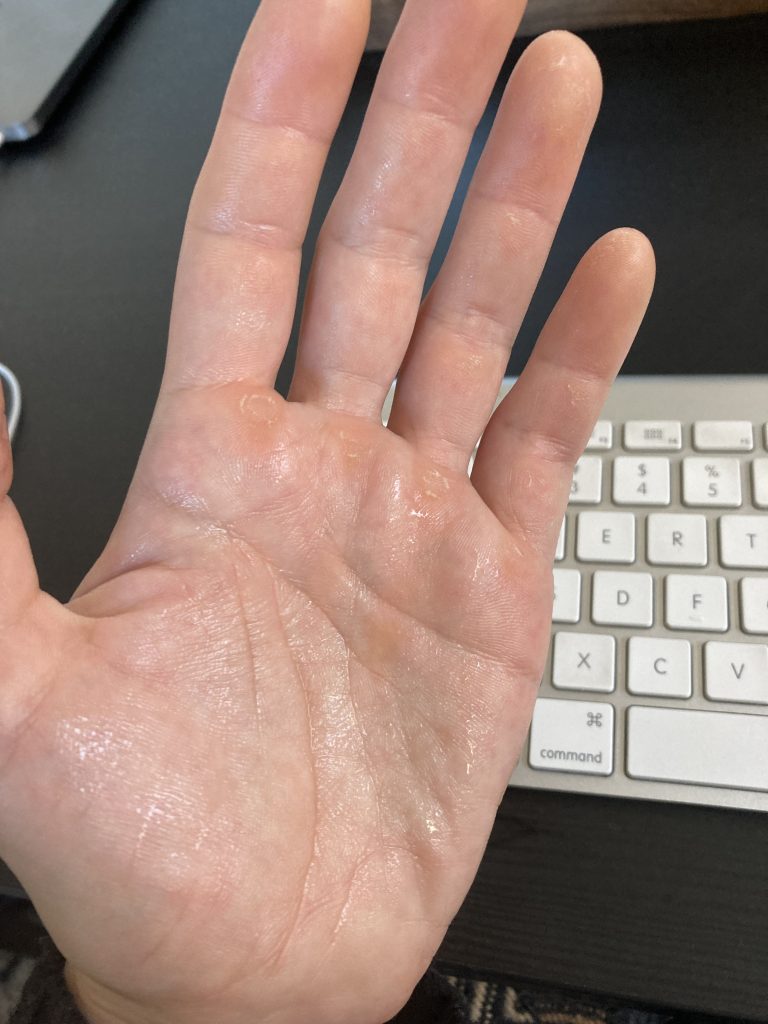
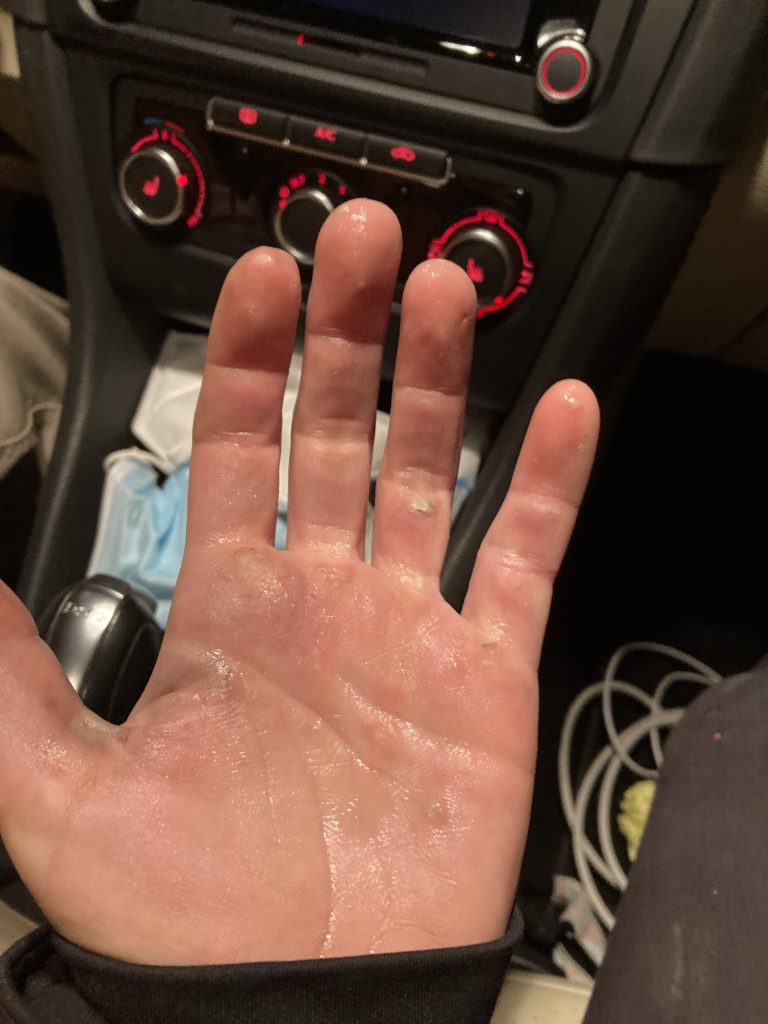
What I tried (and didn’t like)
– Liquid chalk
This one is very simple: liquid chalk just didn’t dry properly on my skin. It turned into a chalky, sweaty, slippery goo. I would rather use nothing than use liquid chalk. Needless to say, the gyms that ruled out chalk in the aftermath of Covid were no-go zones for me.
– Antihydral
When I tell people that I have sweaty skin, the first thing they say is “have you tried Antihydral?” Yes, yes I have. And it was not good. Antihydral is a medicated cream that you can get without a prescription. It thickened my skin (like it’s supposed to), but the skin was just as wet as ever. So, thick skin would peel off in layers over a period of weeks.
Antihydral was helpful for a day or two before the shedding would begin. But no matter what I tried (and I tried a lot of different application protocols, doses, sanding, and moisturizing over a period of years), it just didn’t really work for me in any sort of sustainable way. Two days of semi-decent skin is not with three weeks of trash skin. I started to describe Antihydral as “doing a deal with the devil”. This is probably best illustrated by photos.
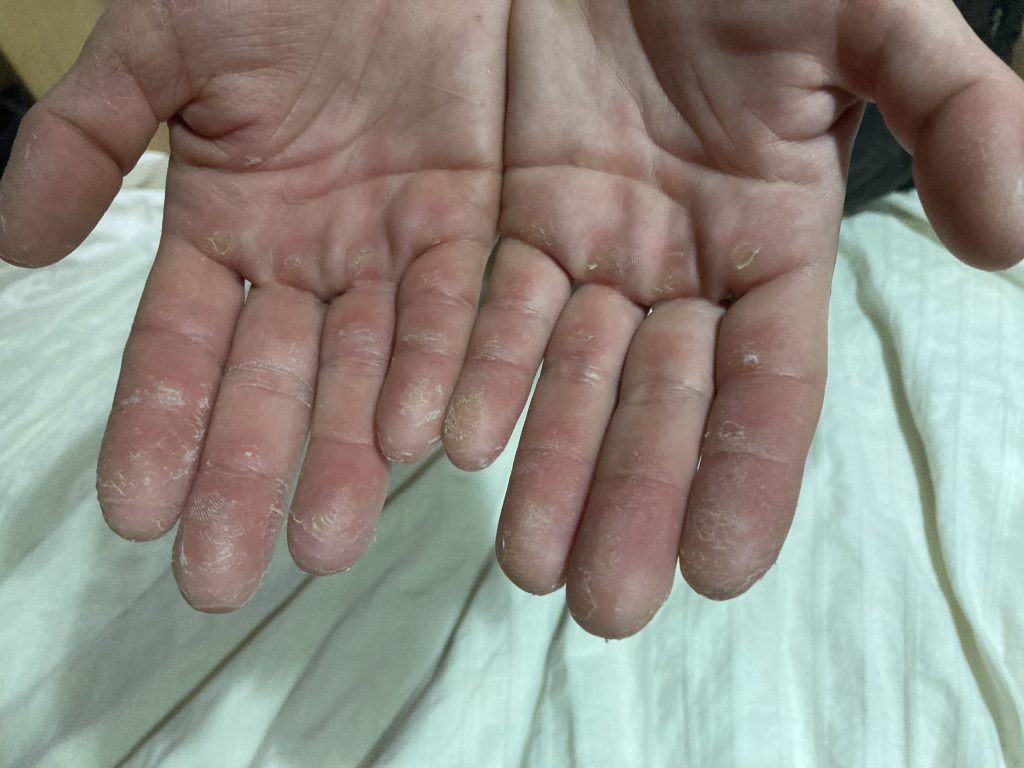
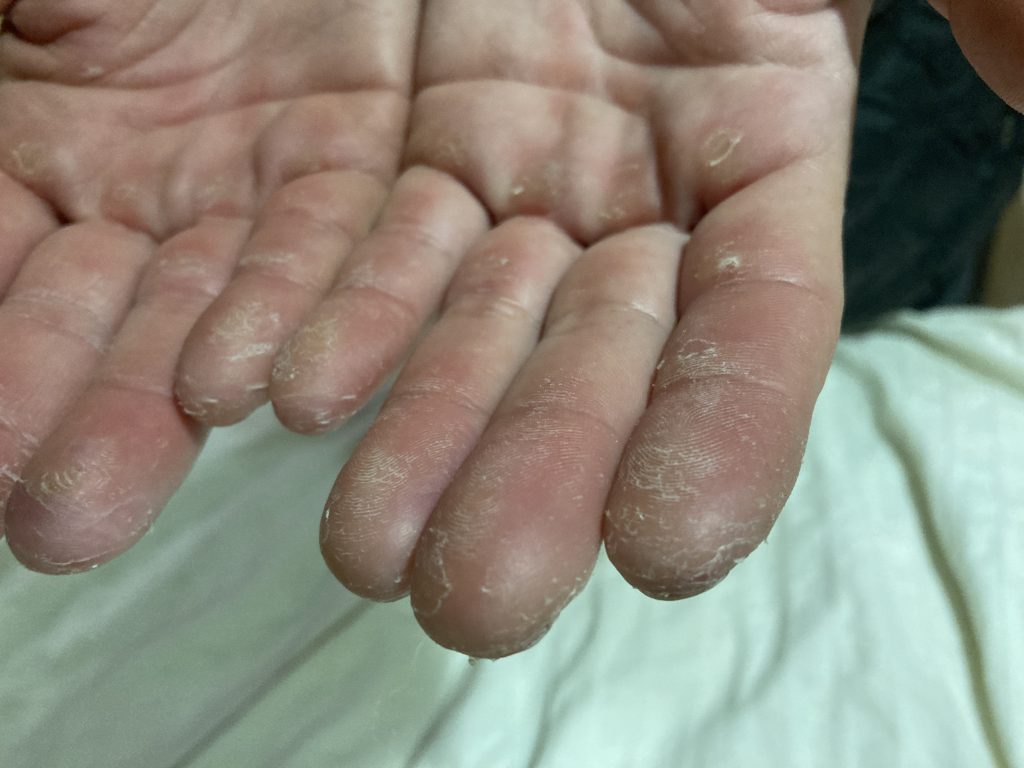
I have heard of other sweaty-handed folk having success with Antihydral, so it’s probably worth a try if you haven’t used it before. You leave it on overnight and it takes days to develop, so start with a small amount and see what happens. One application would affect my skin for 3-4 weeks, so use an abundance of caution. These days, you can buy Antihydral on Amazon, and Magnus Midtbø has a great Youtube tutorial for how to use it. There are also a bunch of reviews of the stuff on the internet.
– Rhino Skin
The drying products that Rhino Skin offers have the same active ingredient as Antihydral: methenamine. In case you don’t know, active ingredients (or “core ingredients”, as Rhino Skin calls them) are the ingredients that cause the effect of the product. For example, Rhino Skin’s Dry Spray lists “Water (l’eau), Isopropyl Alcohol, Methenamine, Magnesium Chloride, Menthol” as ingredients, but only “Methenamine 8%: Antiperspirant” and “Alcohol: Degreaser” as “core ingredients.
For me, the effects were the same. The dosage was a little easier to control, though, so if Antihydral works for you – or if you haven’t tried it and want to experiment – Rhino Skin could be a good place to start. The Dry Spray mentioned above is to dry out your whole hand, including your palms, while Mikey’s Tip Juice is for your fingertips only – it has a little more methenamine (12% vs. 8%) so it’s a bit stronger.
FYI: Rhino Skin Performance also has methenamine in it, but the concentration is not listed. According to the Rhino Skin website, “Rhino Performance sets itself apart from other products like Antihydral by being specially formulated with the same active ingredient but with a lower concentration to help prevent splits and cracks those additional products can cause.” Splits and cracks are not a concern, so I never tried Performance. But I’ve included it here to flag the presence of methenamine. If you don’t like what it does to your skin, you probably won’t like this product.
– Iontophoresis
This was the most extreme thing that I tried. Iontophoresis is a sweaty hand treatment in which you immerse each hand in a separate container of tap water, connect them to some sort of power supply, and run an electric current through your body – first in one direction, then in the other. It’s kind of hard to explain, so here’s a detailed blog post from Mark Anderson (of the Anderson brothers, who wrote the Rock Climber’s Training Manual).
To my knowledge, exactly how iontophoresis produces a drying effect is not yet known – but there is scientific evidence that it works. You can get FDA-approved iontophoresis machines for hundreds of dollars online (Google it). I decided to make my own for a small fraction of the price. There are lots of internet guides out there for how to do so, and it’s covered in Mark Anderson’s blog linked above. Here’s my setup.
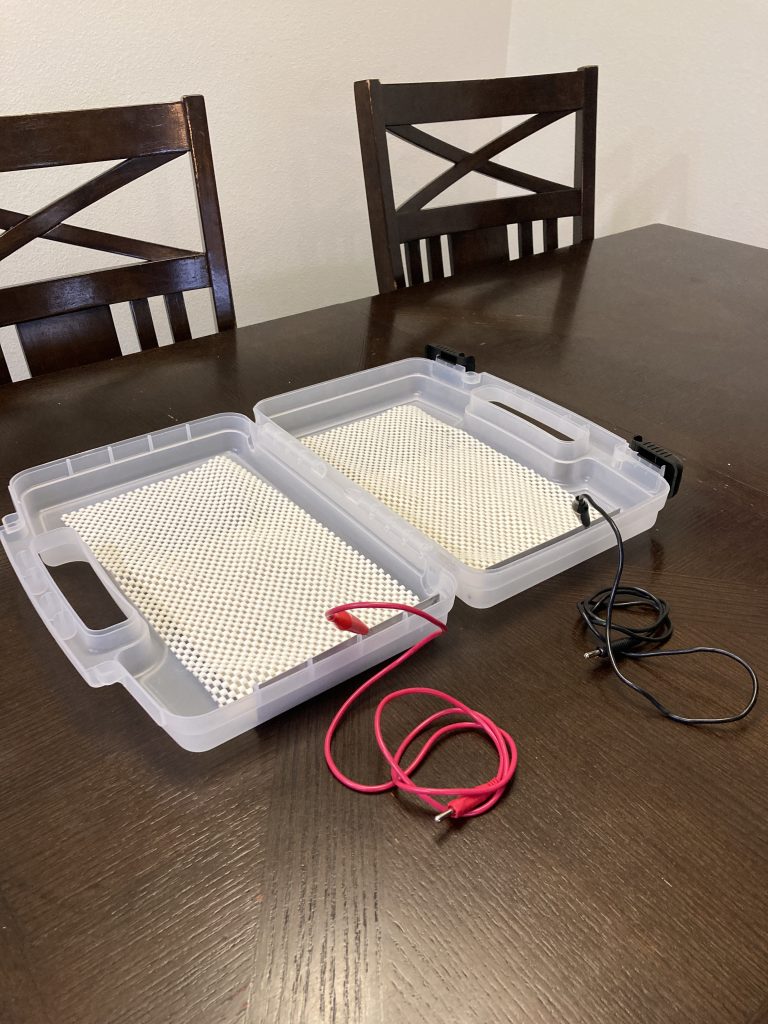
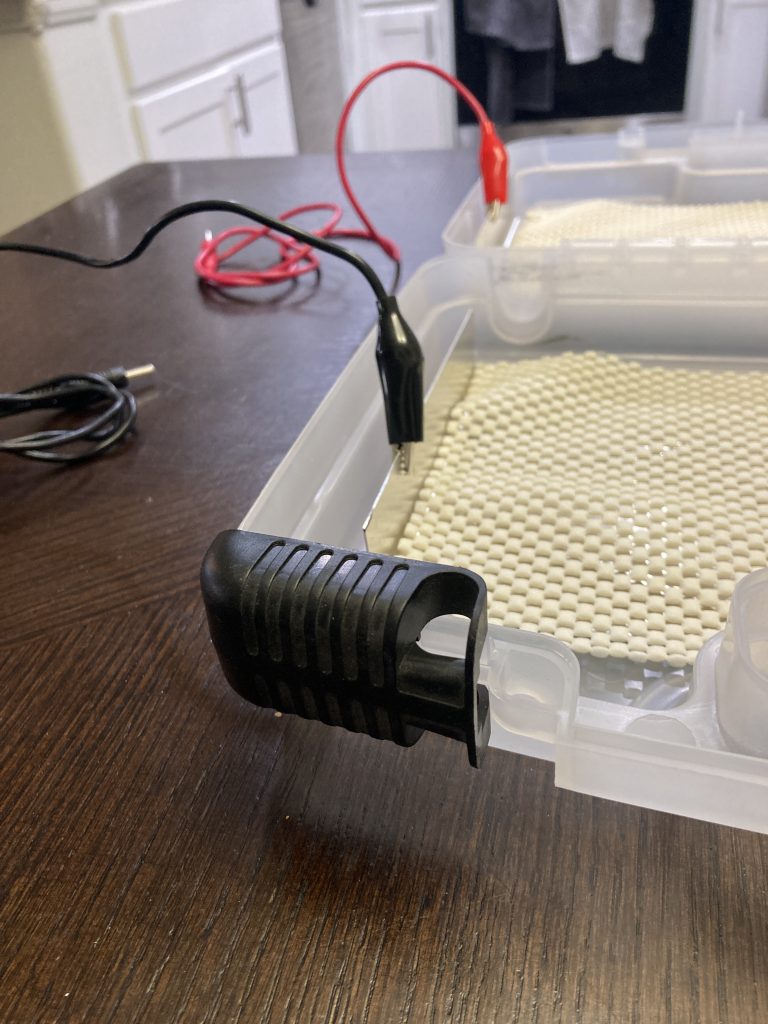
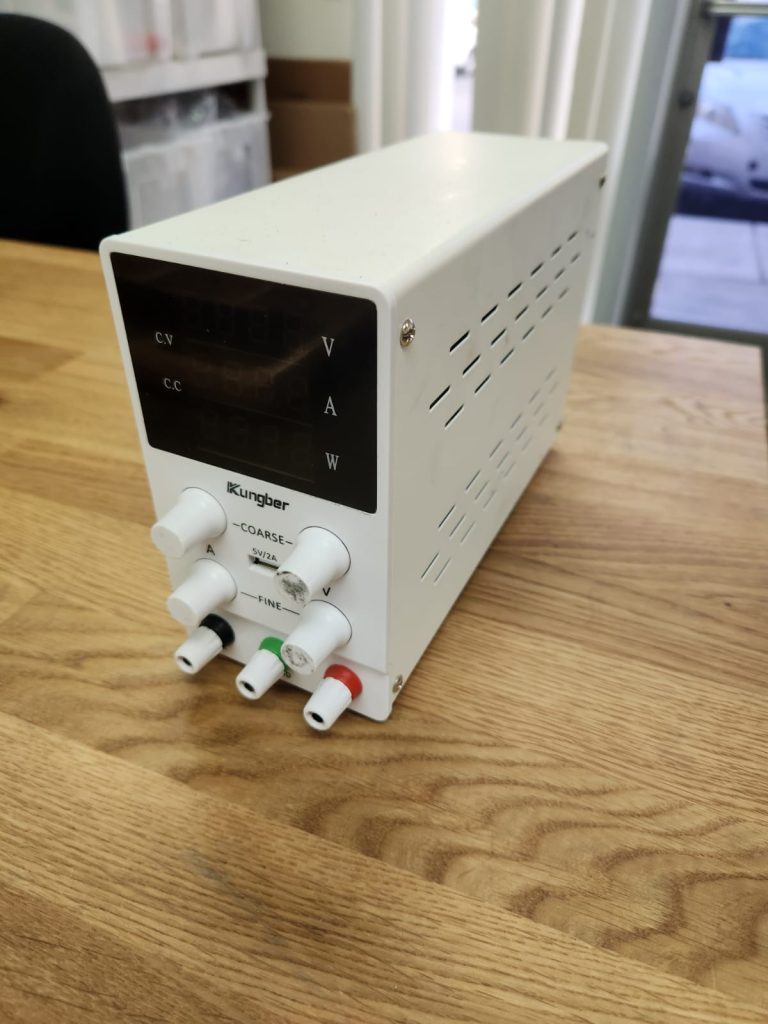
I used a plastic tote thing that folds out in two. On each side, I have a piece of metal covered by an anti-slip dish mat thing (for comfort). Alligator clips connect the two metal pieces to the power source, which is pictured separately as I no longer have it (here’s a link to the one I used). To reverse the polarity – i.e. send the current in the opposite direction – you just switch where the alligator clips are connected. (This is necessary because you treat one hand with the current flowing one way and the other when it’s reversed.)
To the point: did it work? Yes, it did. But it’s extremely impractical in my opinion, especially if you’re a rock climber. First, you have to immerse your hands in water for 20 minutes at a time (10 minutes for each direction of current), and you have to do it multiple times a week. Apparently, you can lower the frequency of treatment as your skin gets drier and tougher, but that never happened to me.
Second, it hurts. You feel the electric shock. It’s not too bad at first – but after five minutes or so, it becomes quite painful. I started calling my setup the “torture device”. Sitting down for 20 minutes with your hands in electric water is not very fun. Third, cuts are a problem. They hurt more. You’re supposed to apply a layer of Vaseline over any cuts or scrapes to protect them but yep, they still hurt. And if you’re a climber, you probably have a bunch of cuts and scrapes on your hands.
So yeah. Iontophoresis does work, but I found it very unpleasant. It seemed unsustainable to electrocute myself for the rest of my climbing life. I figured that there must be a better way, and I kept searching.
– Carpe (over-the-counter antiperspirant)
You can get Carpe on Amazon, and it has pretty good reviews, so I decided to try it. It didn’t really work for me – but it did work for a friend of mine, so it could still be worth a try if you have sweaty skin that’s less, erm, soaking wet than mine.
My issue with Carpe was that it only really had any effect when the lotion was on my skin – and a small effect at that. Like Antihydral, you apply it at nighttime and sleep with it on – but also during the day (twice). When I was climbing, I could really feel the slippery lotion on my skin so I would always end up washing it off.
Apparently, you can apply it less after you’ve used it for four weeks – but I never got there. Carpe dried my skin out some, but the slight drying effect wasn’t worth climbing with slippery lotion hands for four weeks (with no guarantee of a less frequent application after that).
By this point, my skin was a problem. I couldn’t climb in warm temps. I couldn’t climb anything any sharp – or anything too smooth (think Rifle’s polished limestone). On rock that doesn’t have much friction (pretty much anything but sandstone), I would slip all over the place. Imagine trying to send your project when it’s wet. That was my life. Before finding what worked for me, I was seriously considering getting an irreversible operation. But then, I found my one true love…
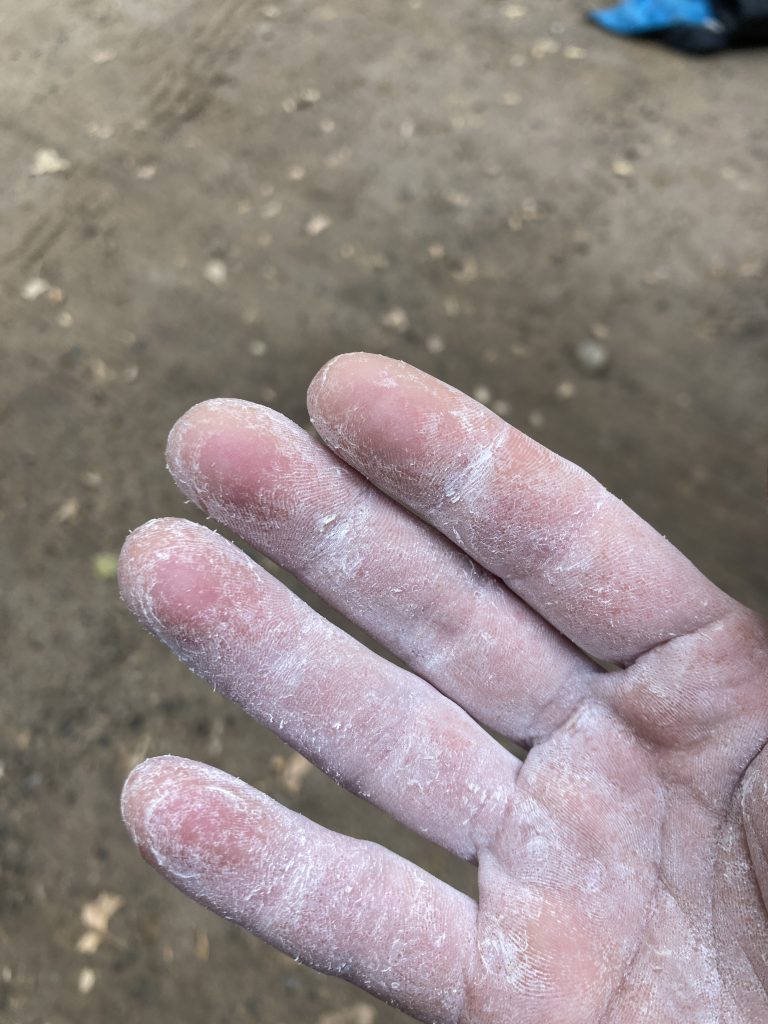
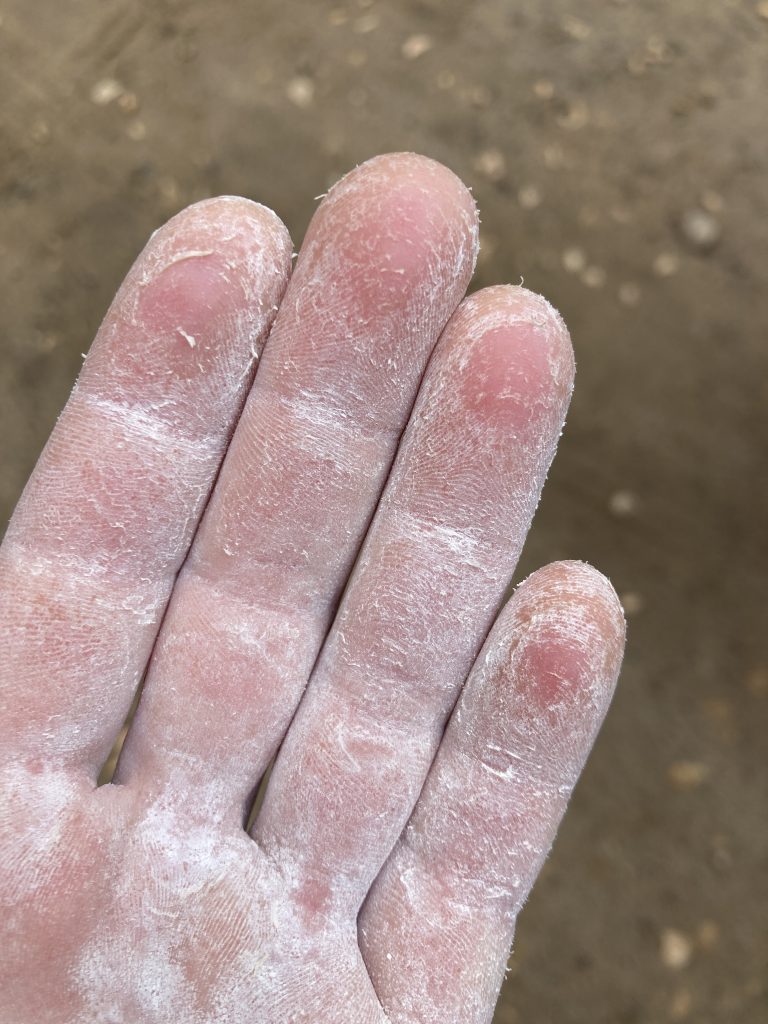
What I tried (and liked)
– Drysol
Drysol’s a prescription antiperspirant with the active ingredient aluminum chloride hexahydrate (20%). It’s strong and amazing. You put it on before sleeping and leave it on overnight. When you wash it off in the morning, what you see is what you get: it doesn’t develop over days like Antihydral and other methenamine products. That makes it much easier to control the dose.
The instructions say to apply overnight until you reach your desired skin dryness, and then once a week to maintain. I mix it up a lot depending on the temps, what kind of rock I’m climbing, and how worn out my skin is. In Hueco, for instance, I apply it to my tips almost every night. But for sandstone bouldering in Vegas, I apply to my whole hand once a week-ish and my tips at least an additional time per week – or more.
But I digress. This stuff works. There are no skin-peeling side effects, and I don’t have to electrocute myself. It’s simple to use and it lets me dry out my skin as much as I want (more for limestone, less for sandstone). It hardens up my tips too. If my skin is worn out, I apply it more frequently – it seems to help me recover faster (or, more likely, my skin wears out less quickly coz it’s not dripping wet).
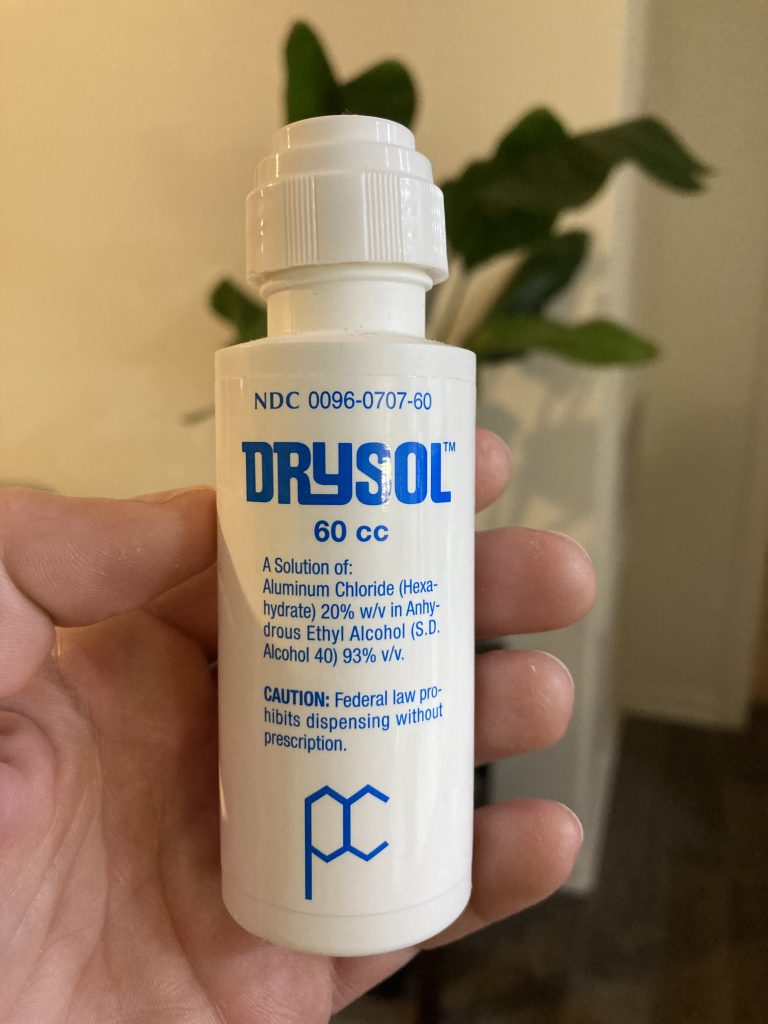
Honestly, Drysol’s kind of magical. I love it. That said, it’s pretty strong. The first time I used it, I applied as much as I could (I’m so used to nothing working) and my skin was insanely dry. I was dry-firing off holds for the first time in my life, which was novel to start with and then annoying. So start small and work your way up, especially if you don’t have super mega sweaty skin. There is one side effect that I experienced: a sort of stinging, burning sensation. This was concerning at first, but then I figured out that moisturizer makes that go away completely. It only happens the day after application, or if I get a little carried away.
As for how to get Drysol, it’s super easy. I used this site to get it online. You have to answer some questions, a doctor will review your answers, and you’ll get a prescription – and then, Drysol will be shipped to your door. I paid $39 for a three-month supply, and the prescription was free.
– Tite Grip II
I’ve used Tite Grip II since 2018. It’s an antiperspirant that you use while climbing – it doesn’t dry your skin out for any longer than you have it on (so its effects end when you wash your hands). Even with Drysol, I still use Tite Grip. It has alcohol in it (like liquid chalk) that gets rid of any oil on your skin, and I find it creates a nice base layer under chalk. I apply it when I get to the gym or the crag, and then again if I wash my hands or eat, or if it’s been a few hours.
– Chalk Cartel
This be chalk. Obviously. But it’s the best chalk I’ve ever found for sweaty hands. It’s not too chunky or too fine, and it doesn’t goop up when your hands sweat. I use Chalk Cartel exclusively. I have it shipped to my house by the kilo. And it’s reasonably priced: $15.95 for a 250g bag. That’s only slightly more than Black Diamond’s White Gold at $14.95 for 300g. And it’s much, much cheaper than other premium chalk like Friction Labs at $25 for 283g.
Since finding Chalk Cartel, I had to buy a bag of Friction Labs one time when I was in a pinch. I threw that bag out as soon as I got my hands on some Chalk Cartel. If you haven’t tried it, I suggest you do.
So, there you have it. I hope this is helpful for my sweaty-handed friends. Please feel free to message me if you have any questions! You can find me @512andbeyond on Instagram – or shoot me a message here. If you found this helpful, drop your email below to get notified when I post new things. Happy drying.
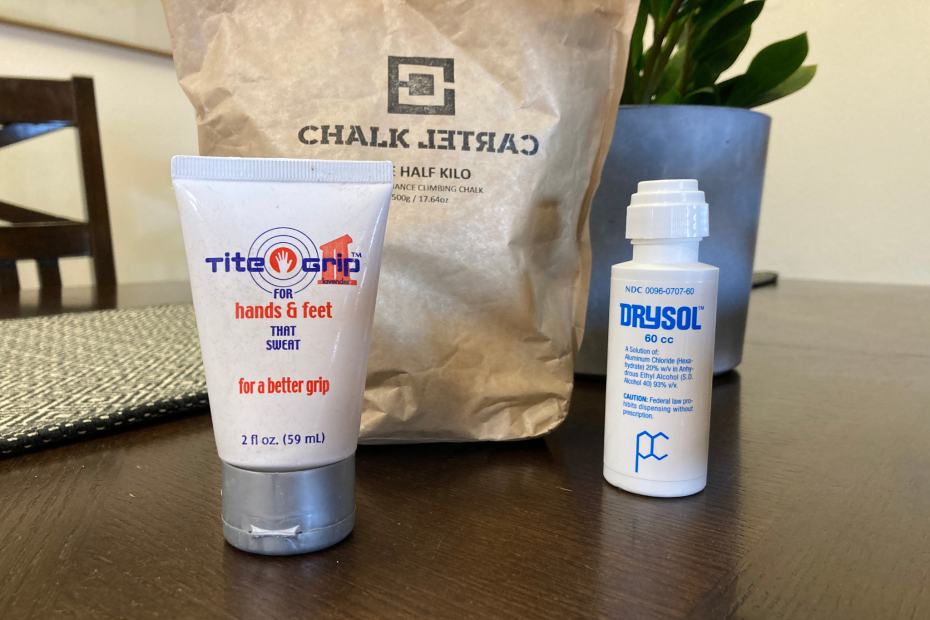
Great read. Awesome that you solved a life long issue. That said, your new nick name: “the claminator”! Which gets Arnolds approval regarding your ability to terminate clammy hands 🙂
Thanks!! Yeah, it’s awesome to finally have it under control after all that time. Hahahahaha perfect, the claminator it is